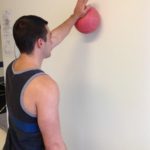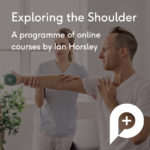Proprioception or our physical awareness of positioning and movement is an important physical sense for coordination, motor skills and prevention of injuries. It falls into the realm of somatosensation, also known as our "sixth sense". Both researchers and clinicians are becoming more familiar with the concept and increasingly realizing its importance in rehabilitation after an injury. The term itself is still in its infancy and has competing definitions. Hence, it can be a challenging concept to apply to clinical practice.
Proprioception is of particular importance for highly mobile joints such as the glenohumeral joint, the stability of which is based on neuromuscular control. Some clinical treatments like kinesiology tape and neuromuscular exercises claim to improve shoulder proprioception, but is it really the case?
What does research tell us?
A recent systematic review by researchers from Belgium and Canada to clarify this central clinical question: Can clinical exercises and / or treatment modalities improve shoulder proprioception in patients with shoulder pathology?
In the case of this review, the pathologies included were; Impingement syndromes, unstable shoulders, anterior dislocations, unspecific shoulder pain, rotator cuff dysfunction and subluxations after a stroke. Treatment strategies were grouped into clinical clusters for analysis, including: conventional therapy, proprioceptive training, elastic kinesiology tape, and other passive therapies.
Conventional therapy : Movement training, manual therapy, stretching, strengthening, exercises for the stability of the shoulder blade, patient education.
Proprioceptive training : flexible film, wobble board training, specific proprioceptive training.
Passive modalities : electrical microcurrent stimulation, transcutaneous electrical nerve stimulation, hot packs, non-elastic adhesive tape or bracing.
The results

The review suggests, with moderate evidence, that proprioceptive training can improve proprioception in the medium term. There is no decisive evidence that conventional therapy provides added value to improve the sense of proprioception of the shoulder. Conflicting evidence has been found of improving proprioception by using a kinesiology elastic band, while moderate evidence suggests that passive modalities are ineffective for proprioceptive rehabilitation of the shoulder.
There may be the possibility of a specificity of the training effect, which means that certain shoulder injuries can have certain proprioception deficit patterns. It would be interesting to further investigate targeted proprioception training for specific shoulder pathologies.
Clinical implications
There are a number of important clinical lessons that we can draw from this systematic review. These are summarized below:
It is worth investigating certain deficits in shoulder proprioception in certain shoulder injuries.
Proprioceptive training at this point shows the strongest evidence of rehabilitation for people with proprioceptive shoulder deficit.
Conventional therapy alone does not directly improve proprioception of the shoulder.
There is conflicting evidence of using kinesiology elastic tape to improve shoulder proprioception.
Why not share these important clinical lessons with shoulder expert Dr. Ian Horlsey in our latest shoulder program?
Research on the shoulder program
 Dr. Ian Horsley is a leading upper extremity physical therapist in the United Kingdom. In this course program he will discuss the etiology, differential diagnosis, assessment and the various management strategies of frozen shoulder, shoulder impingement syndrome and sternoclavicular joint dysfunction.
Dr. Ian Horsley is a leading upper extremity physical therapist in the United Kingdom. In this course program he will discuss the etiology, differential diagnosis, assessment and the various management strategies of frozen shoulder, shoulder impingement syndrome and sternoclavicular joint dysfunction.
Shoulders do not have to be complex